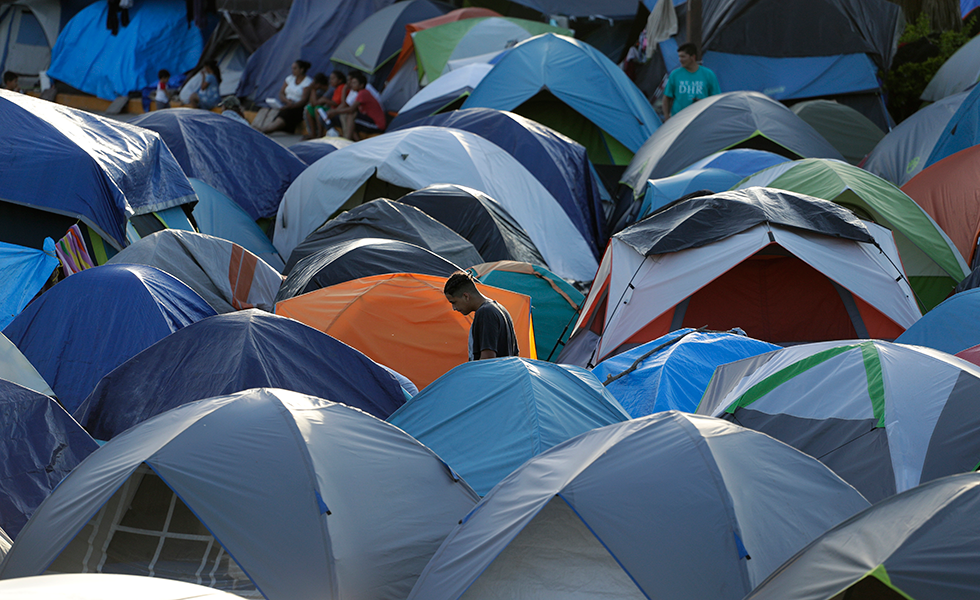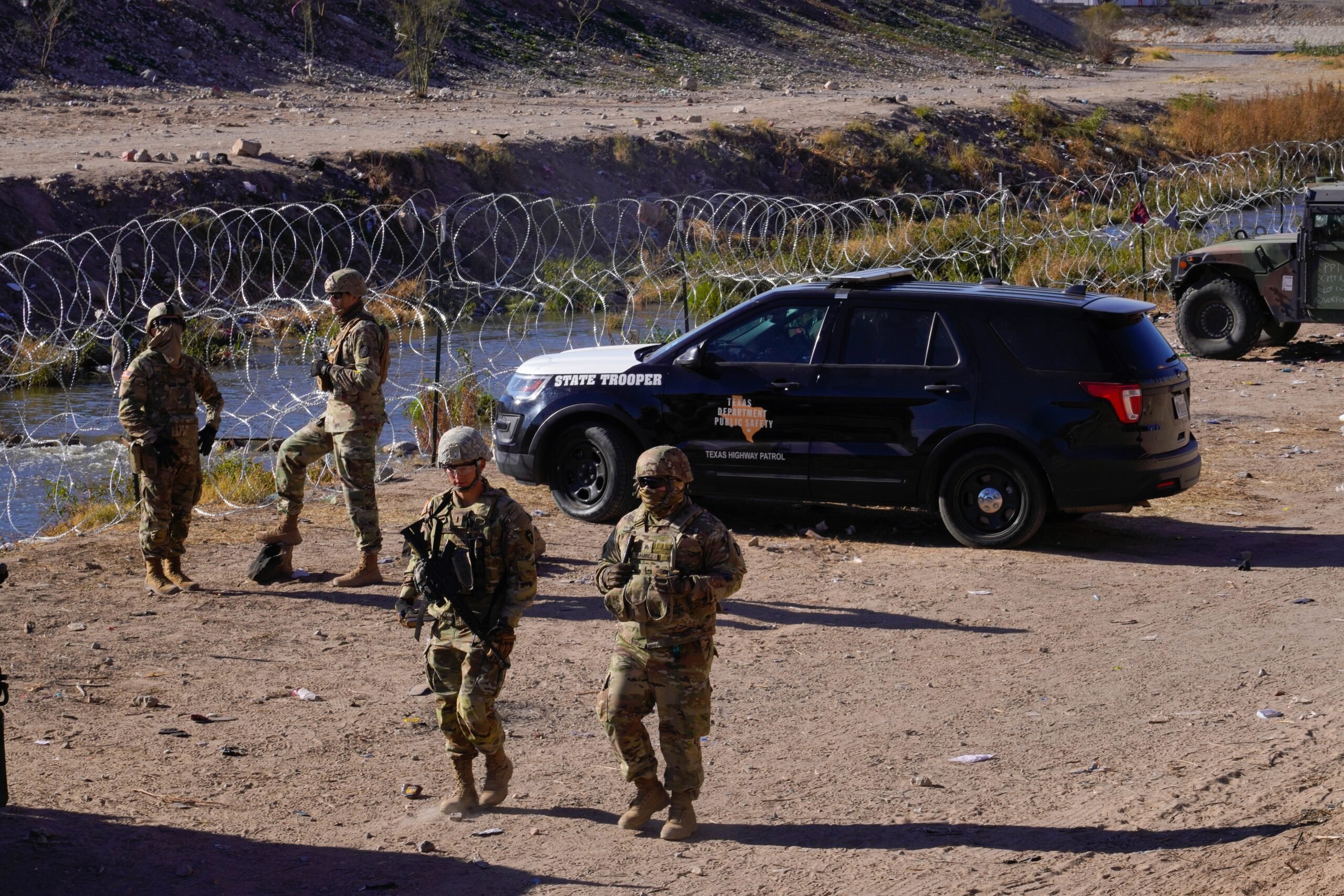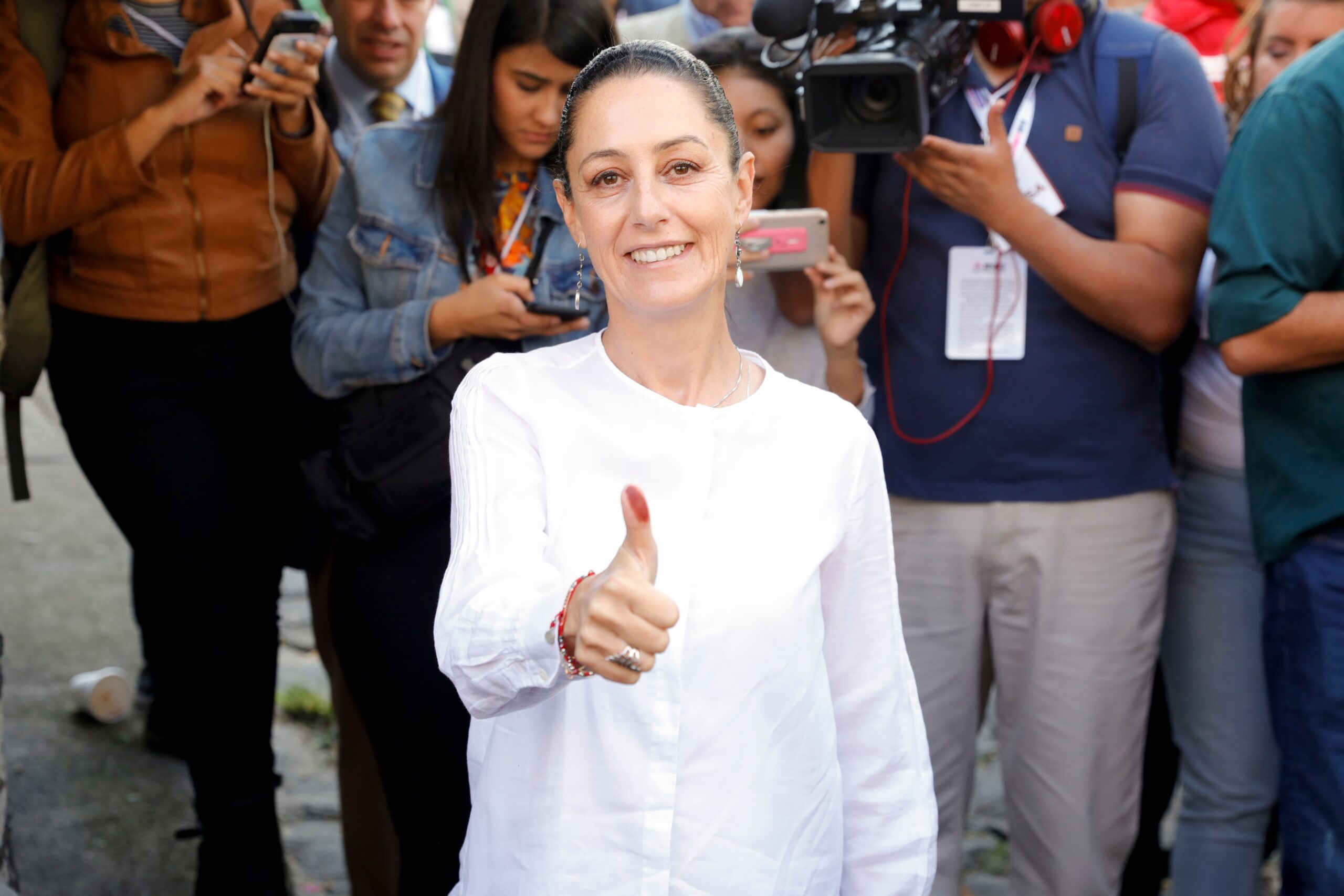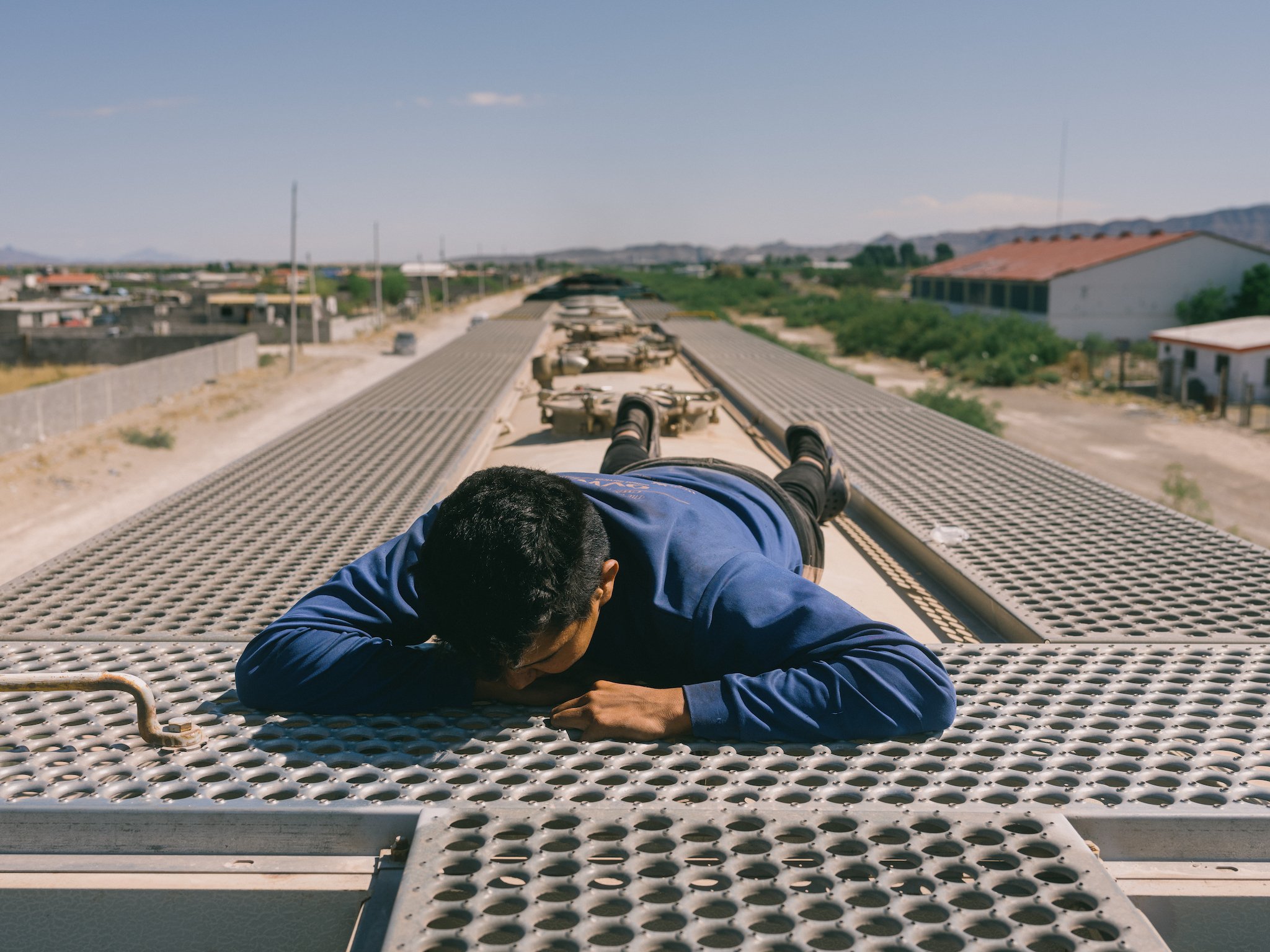
In Migrants Camps Along the Texas-Mexico Border, Close Quarters and Closing Borders Raise Concerns
Advocates and lawyers warn new measures implemented along the southern border in response to COVID-19 are putting vulnerable migrants at higher risk.
Above: A migrant walks through a refugee camp in Matamoros in November 2019. In Matamoros, as in all other refugee camps worldwide, CDC recommendations on social distancing are not possible.
COVID-19 is lurking along the Texas-Mexico border. As suspicious illnesses begin to appear in migrant camps, close proximity, unhygienic conditions, and travel remain inexorable parts of daily life there.
Mexican border cities Matamoros and Juárez both have at least one confirmed case of the virus, while Cameron County and El Paso—their U.S. neighbors—have multiple cases. The U.S. government has begun taking action along the border to stop the spread of the virus, including postponing court hearings scheduled through April 22 for asylum-seekers waiting in Mexico under the Migrant Protection Protocols (MPP).
But the pandemic and some of the new measures pose new challenges for immigration advocates, volunteers, and lawyers who are working around the clock to ensure that migrants affected by MPP—who are currently living in large open-air camps—are prepared, informed, and protected.
Medical aid organization Global Response Management (GRM) has been providing urgent care services for the nearly 2,000 migrants in Matamoros since October. Helen Perry, a nurse practitioner and the executive director of GRM, said there are five patients with symptoms in the camp that the organization reported to local authorities. Though they tested negative for the flu, GRM was unable to obtain COVID-19 testing. According to GRM’s assessment, one patient was in critical condition and four were classified as moderate.
GRM has recommended that the Mexican government allow patients with symptoms to go to nearby hotels or move to areas away from the camp for isolation. However, Perry said Mexican immigration authorities, who control the movement and location of the migrants, have yet to allow measures for distancing and isolation. Representatives from the Instituto Nacional de Migración could not be reached for comment.
“I took a woman that was pregnant and having premature labor [to the hospital]. The gate was locked, nobody got up from their chairs. We had to go find a wheelchair ourselves.”
GRM has been working on setting up a 20-bed field hospital near the camp’s southern edge, which they hope to have ready by the first full week of April. The hospital had been in the works for some time, but when the virus began to rapidly spread two weeks ago, GRM met with Matamoros officials to hasten the process. GRM fears that the city won’t be able to respond to a catastrophic health event of this magnitude: There is a lack of readily available tests in the city, local public hospitals are only taking life-threatening emergencies, and city officials told GRM that Matamoros only has 10 ventilators that they are unsure are even usable.
“You can’t give something you don’t have,” Perry said.
In Matamoros, as in all other refugee camps worldwide, Centers for Disease Control and Prevention (CDC) recommendations on social distancing are not possible. Migrants cannot isolate, wash their hands frequently, or practice necessary hygiene. Perry says GRM has been working to educate migrants on condition-specific precautions, such as mopping instead of sweeping, sleeping head-to-toe in ventilated tents, and using the 40 additional handwashing stations the group recently installed.
A spokesperson for the city of Matamoros said they were not too concerned about the migrants because they had not traveled recently to countries with high numbers of COVID-19 cases. The city’s secretary of health, Miriam Maldonado, was unavailable for comment at the time of publication.
The limited access to public health care has affected migrants’ ability to receive other treatments, according to Gaby Zavala, who provides legal assistance with aid organization Resource Center Matamoros. “I took a woman that was pregnant and having premature labor [to the hospital],” Zavala said. “The gate was locked, nobody got up from their chairs. We had to go find a wheelchair ourselves.”
Resource Center Matamoros continues to process new asylum claims and paperwork for recent arrivals to the camp through WhatsApp and video calls. Meanwhile, they are giving information sessions to the migrants about updates in the immigration system and health and safety measures.
If immigration courts were to close, attorneys fear there won’t be a way to communicate with people in Mexico.
Zavala said the Mexican government has been bringing buses to the camp daily that take migrants to the Mexico-Guatemala border, but her group has been unable to confirm their destination, which populations agents are asking to board, or what happens to pending court dates in the United States. In the meantime, legal experts are reminding migrants MPP is not canceled, only postponed, and they’re working with volunteers to provide resources during migrants’ extended stay in the camp.
Aid organization Team Brownsville has been on the ground accumulating resources and planning for the pandemic for weeks. “This isn’t something that happened overnight; we saw this coming,” said Andrea Rudnik, Team Brownsville’s co-founder.
Rudnik said the most notable impact of the pandemic thus far is a decrease in the number of available volunteers. The organization has asked the formerly full schedule of 30 to 50 volunteers to remain home, but the leaders of Team Brownsville have taken it upon themselves to continue providing help. For now, their travel is considered essential, but they gave a key to the storage units full of supplies to a team member based in Matamoros in case they are unable to cross.
“We are not going to leave the people without goods and services—that wouldn’t be fair,” Rudnik said.
Rudnik, who has developed a cough and fever this week, and other volunteers are cognizant that they are putting themselves at risk. They have plans in place if they are unable to carry food across the bridge every day, but until then, they continue to go. “These people are not just nameless faces, these are people we know and care about,” Rudnik said. “It’s hard not to go.”
Still, all the preparation hasn’t lifted a somber mood that has overshadowed the camps. In Juárez, Tania Guerrero, an attorney with the Estamos Unidos Asylum Project, said uncertainty and the rapid spread of the virus is putting everyone in danger, especially the children, elderly, and immunocompromised in the shelters. And the future pending asylum cases are uncertain.
Guerrero said migrants at the shelters received an informal notice from CBP on Monday that those with court hearings should still present themselves to receive notices for new court dates. Even showing up can be a burden. First, asylum-seekers must scrape together the money for transportation. And from the Juárez camps, the trip involves waking up at 2:30 or 3 a.m. with their children to make it to the hearings.
If immigration courts were to close, Guerrero said, attorneys fear there won’t be a way to communicate with people in Mexico (courts usually mail notices), and authorities will resort to making migrants travel to ports of entry to receive notices.
With little supplies, low funds, and a less-than-optimal health care system in Juárez, Guerrero said she’s worried that an influx of illnesses in the shelters would topple the health care system. Forcing migrants to come and go from the ports of entry also creates more danger.
She said her colleagues who have accompanied asylum-seekers to present themselves at ports of entry are being immediately turned away. Some return injured from the attempted journey, including cuts and fractures incurred while hiking through the desert. “[A colleague] told me it was horrific to watch how in the pitch black of la madrugada, people were crossing on the bridge, being dumped back,” Guerrero said.
Correction: An earlier version of this article stated that Gaby Zavala is an attorney. She provides legal assistance. The Observer regrets the error.
Find all our coronavirus coverage here.
Read more from the Observer:
-
Loneliness in the Age of Coronavirus: As a single parent, I was already struggling with loneliness. Then the coronavirus hit.
-
The New U.S. Food Safety Czar is a Texas Researcher with Close Ties to the Meat Industry: Mindy Brashears’ confirmation comes at a time when Americans are scouring supermarket aisles for safe food to eat.
-
COVID-19 Could Be a ‘Double Whammy’ for Those in Pollution Hotspots: Texans who breathe polluted air are more likely to have preexisting health issues. That means they’re at a higher risk of getting seriously ill from the coronavirus.


